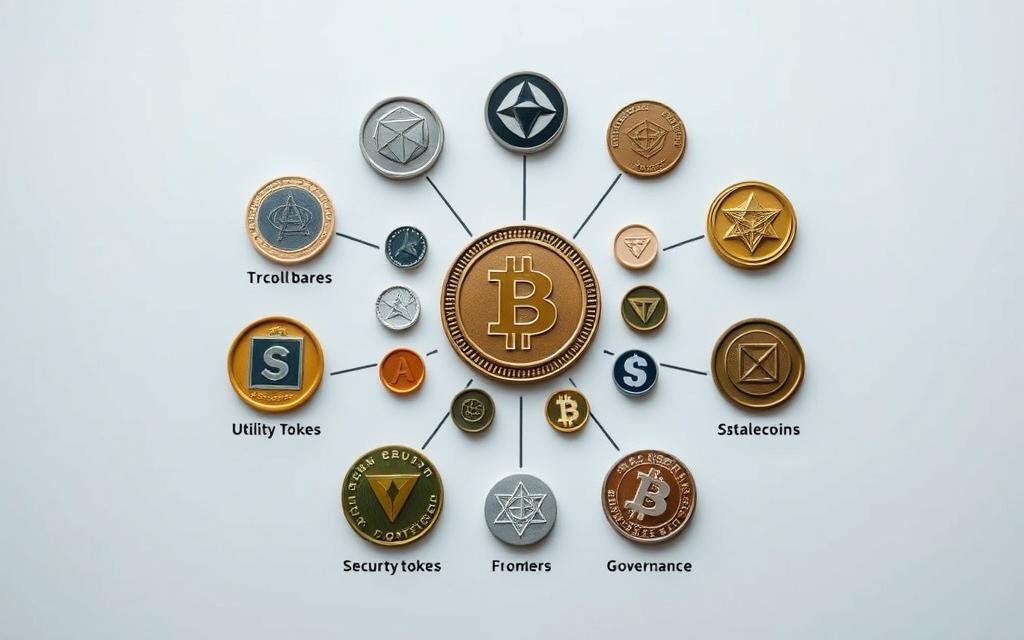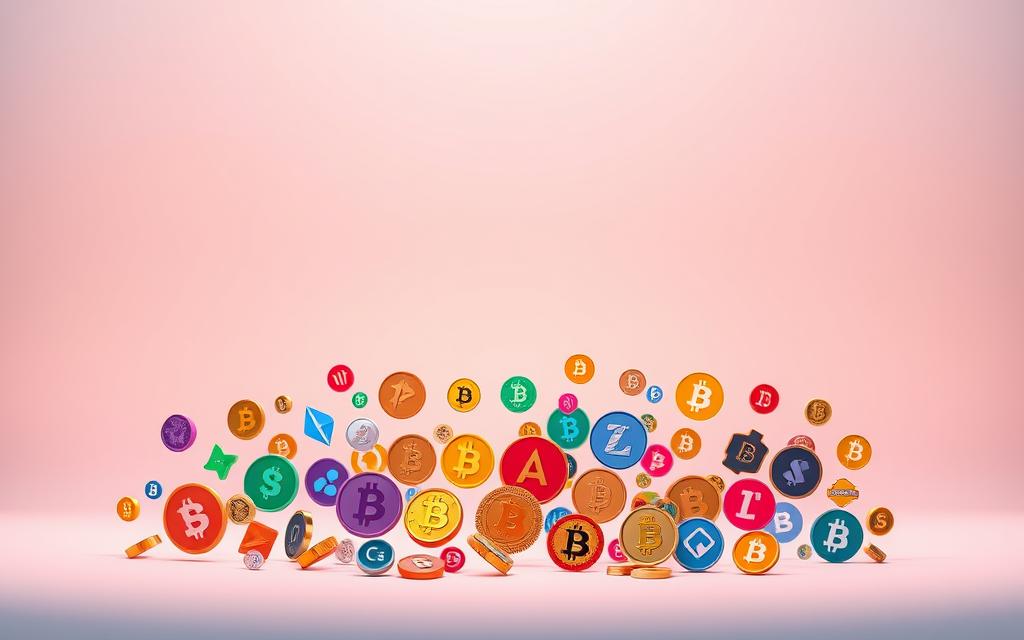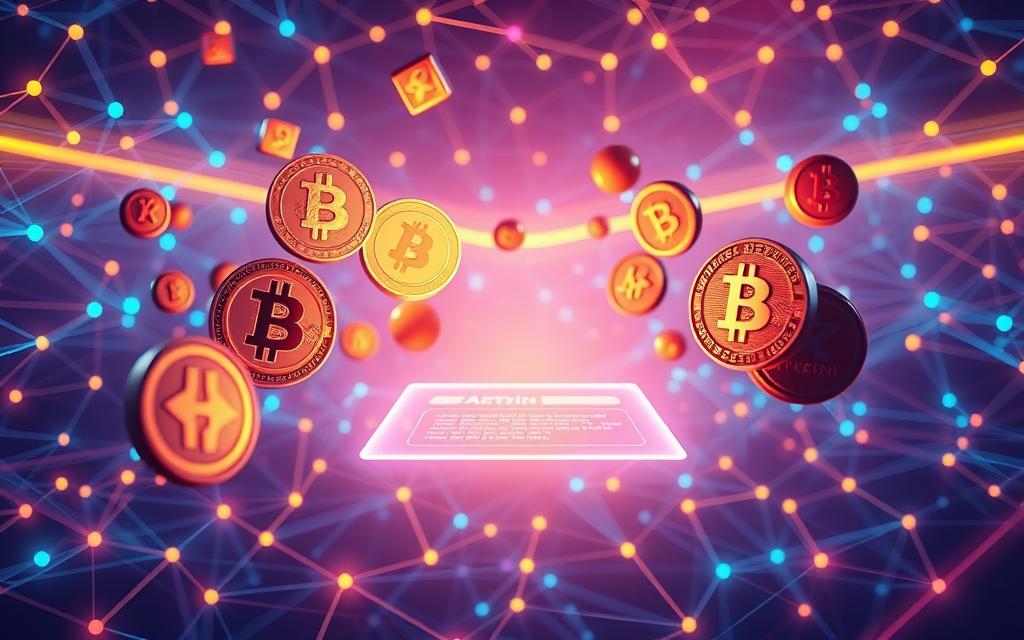Table of Contents
Modern blockchain technology goes beyond just currencies like Bitcoin. Crypto tokens represent a versatile digital asset class built on existing networks. Unlike native cryptocurrencies, these units operate on established blockchains like Ethereum.
These digital assets serve multiple purposes beyond simple transactions. They can represent ownership, access to services, or even virtual real estate. Projects like Decentraland use them for land parcels, while stablecoins like Tether maintain value pegs.
Most tokens rely on smart contracts for automated functionality. This enables features like decentralized governance or reward distribution. Cryptographic security ensures tamper-proof transactions across the network.
The flexibility of blockchain-based tokens continues to drive innovation. From gaming assets to financial instruments, their applications keep expanding across industries.
Introduction to Crypto Tokens
Tokenization is reshaping finance by digitizing ownership and access rights. These digital assets function as programmable units on distributed ledgers, enabling seamless transfers of value. Unlike physical assets, they operate on blockchain networks like Ethereum, where smart contracts automate their behavior.
The concept emerged with Ethereum’s 2015 launch, introducing programmable tokens beyond simple currency use cases. Projects quickly adopted them to represent everything from virtual land parcels to governance rights. For example, CryptoKitties (2017) popularized NFTs, while Uniswap’s tokens decentralized platform control.
Key advantages over traditional assets include:
- Transparency: All transactions are publicly verifiable on-chain.
- Divisibility: Tokens can represent fractional ownership, like shares in real estate.
- 24/7 markets: Trading occurs globally without intermediaries or downtime.
As digital keys for ledger systems, tokens bridge physical and digital economies. Their adaptability continues to drive innovation across DeFi, gaming, and beyond.
What Is a Crypto Token?
Smart contracts power a new era of digital ownership and utility. These programmable agreements define how crypto tokens operate, ensuring automated compliance and transparency. Unlike static assets, they adapt to diverse use cases—from governance to rewards.

Key Characteristics of Crypto Tokens
Smart contract governance eliminates intermediaries. For example, the *ERC-20* standard enables tokens like DAI to stabilize prices autonomously on Ethereum. Rules are embedded in code, reducing human error.
Interoperability lets these units function across decentralized apps (dApps). A gaming token might later serve as collateral in DeFi—all on the same blockchain. This flexibility fuels innovation.
Ownership records are immutable, stored securely on distributed ledgers. Every transfer is traceable, reducing fraud risks. Fractional ownership becomes seamless, unlocking micro-investments in real estate or art.
Programmable features automate complex actions. Tokens can distribute dividends, grant voting rights, or even burn supply to adjust scarcity. The DAI stablecoin exemplifies this, adjusting issuance based on demand.
- Automated compliance: Rules execute without third parties.
- Cross-platform utility: Tokens work across ecosystems.
- Transparent history: All transactions are stored blockchain-wide.
Crypto Tokens vs. Crypto Coins: Key Differences
Digital assets come in various forms, with crypto tokens and coins serving distinct roles in blockchain ecosystems. While both operate on distributed ledgers, their underlying architectures and purposes diverge significantly.
Native Blockchain vs. Existing Blockchain
Coins like Bitcoin and Ethereum are native to their own blockchains. They function as the primary currency for transactions and network security. In contrast, tokens such as ERC-20 assets rely on existing infrastructures like Ethereum’s smart contracts.
Key structural differences include:
- Base layer vs. application layer: Coins power core blockchain operations, while tokens enable dApp functionalities.
- Development requirements: Creating a coin demands building a new blockchain, whereas tokens deploy on established networks.
- Transaction costs: Token transfers incur gas fees (e.g., ETH for ERC-20), unlike native coin transactions.
Purpose and Utility
Coins primarily act as a medium of exchange or store of value. Tokens, however, offer multipurpose utilities—from governance voting to asset representation. For example, Uniswap’s UNI token grants protocol voting rights, while Tether’s USDT stabilizes value as a fiat-backed asset.
Functional contrasts highlight:
- Regulatory distinctions: The SEC’s Howey Test may classify some tokens as securities, unlike most coins.
- Interoperability: Tokens often function across multiple platforms within a blockchain ecosystem.
- Programmability: Smart contracts enable tokens to automate complex actions like dividend distributions.
Types of Crypto Tokens
Digital ownership evolves through distinct token categories, each serving unique purposes. These units range from granting platform access to representing fractional real estate, all secured by blockchain technology.

Utility Tokens
Utility tokens provide access to specific services within decentralized ecosystems. Chainlink’s LINK, for example, powers oracle networks that feed real-world data to smart contracts. Holders use these assets to pay for blockchain-based computations or voting rights.
Security Tokens
Security tokens digitize traditional investments like stocks or real estate. Projects like RealT tokenize properties, enabling fractional ownership for holders. These assets often comply with SEC regulations, offering dividends or profit shares.
Non-Fungible Tokens (NFTs)
Non-fungible tokens authenticate unique digital items, from NBA Top Shot highlights to CryptoKitties. Unlike interchangeable units, NFTs prove scarcity and ownership for art, collectibles, or virtual land.
Stablecoins
Stablecoins like USDC or Tether maintain stable values by pegging to fiat currencies. Their smart contracts adjust supply dynamically, ensuring minimal price volatility for traders and DeFi users.
- Emerging Types: Social tokens (e.g., Rally) reward community engagement, while wrapped assets (wBTC) bridge Bitcoin to Ethereum.
How Do Crypto Tokens Work?
Blockchain-based digital assets operate through automated protocols and decentralized networks. These systems enable seamless creation, transfer, and verification of units like ERC-20 tokens across the Ethereum blockchain.

Smart Contracts and Token Creation
Developers use programming languages like Solidity to mint new units on the Ethereum blockchain. The ERC-20 standard defines rules for fungible assets, while ERC-721 governs NFTs. Every deployment requires:
- Gas fees to prioritize transaction execution
- Security audits by firms like CertiK to verify contract integrity
- Layer 2 solutions (e.g., Arbitrum) to reduce network congestion
Transaction Processing
Validators confirm transfers by solving cryptographic puzzles. Users pay variable gas fees based on network demand—higher fees accelerate processing. Cross-chain bridges (Polygon) enable interoperability between separate ledgers.
All activity is permanently stored blockchain-wide, ensuring tamper-proof records. This transparency allows anyone to verify token supplies or transaction histories without intermediaries.
Examples of Popular Crypto Tokens
Leading projects demonstrate the transformative power of tokenized solutions. Name-brand assets like Tether and Chainlink highlight the Ethereum blockchain’s versatility, while Decentraland pioneers virtual real estate markets.

Tether (USDT)
With a $110 billion market cap, USDT dominates stablecoin adoption. Its omnichain presence spans 14 networks, enabling seamless cross-border transactions. Unlike volatile assets, Tether maintains a 1:1 USD peg through reserved backing.
Chainlink (LINK)
LINK powers over 1,700 oracle networks, bridging smart contracts with real-world data. Its Price Feeds underpin DeFi platforms, ensuring accurate asset valuations. Built on the Ethereum blockchain, it exemplifies programmable utility.
Decentraland (MANA)
MANA fuels a $1.6 billion metaverse economy, where users trade virtual land parcels. Partners like Sotheby’s host NFT galleries, merging digital and physical real estate. This showcases tokens as ownership certificates.
Emerging examples include Render (decentralized GPU sharing) and Filecoin (storage solutions). Conversely, TerraUSD’s collapse underscores the risks of algorithmic stablecoins.
Why Are Crypto Tokens Important?
Tokens redefine value exchange in decentralized ecosystems. They power innovations like decentralized finance (DeFi) and digitize real-world assets, bridging gaps between traditional and blockchain-based systems.
Enabling Decentralized Finance (DeFi)
DeFi protocols like Aave disrupt traditional banking by offering permissionless lending. Over $100B is locked in DeFi, according to Motley Fool, showcasing their global impact.
Key advantages over conventional finance:
- 24/7 access: No bank holidays or intermediaries.
- Transparency: All transactions are auditable on-chain.
- Higher yields: Automated protocols optimize returns.
Tokenization of Assets
From Andy Warhol’s NFTs to tokenized real estate, fractional ownership democratizes investments. Projects like VeChain extend this to supply chains, tracking goods via blockchain.
Emerging use cases include:
- Gaming economies: Axie Infinity’s AXS rewards players.
- Identity management: Civic’s KYC tokens streamline verification.
“Tokenization could unlock $10T in illiquid assets by 2030.”
How to Create and Use Crypto Tokens
Building digital assets requires understanding blockchain protocols and smart contract mechanics. Developers leverage standardized frameworks like ERC-20 to deploy cryptocurrency tokens efficiently. This process democratizes asset creation while ensuring interoperability across decentralized apps.
Steps to Create a Token
Launching a new unit involves strategic planning and technical execution. Start by drafting a whitepaper outlining utility, supply, and distribution. Next, select a blockchain like Ethereum or Solana for deployment.
Key phases include:
- Smart contract coding: Use OpenZeppelin’s audited templates for security.
- Testing: Deploy on testnets (Ropsten) to identify vulnerabilities.
- Mainnet launch: Allocate gas fees for contract deployment.
Post-launch, focus on liquidity provision and exchange listings. Platforms like CoinMarketCap require verified trading volume for inclusion.
Platforms for Token Development
Ethereum dominates with 80% of altcoin projects, per Gemini. However, alternatives offer niche advantages:
- Binance Smart Chain (BSC): Lower fees but centralized validators.
- Solana: High-speed transactions for gaming tokens.
- Polygon: Layer 2 scaling for Ethereum-compatible assets.
Legal compliance varies by jurisdiction. The SEC may classify tokens as securities, requiring registration. Offshore options provide flexibility but risk regulatory scrutiny.
“ERC-20’s standardization reduces development time by 70% compared to custom blockchains.”
For deeper insights, explore crypto tokens and their regulatory frameworks.
Conclusion
Tokenization unlocks new opportunities across finance, gaming, and digital ownership. The blockchain revolution continues to expand, with real-world assets and institutional players entering the space.
Key trends shaping the future include RWA tokenization and clearer regulations. BlackRock’s BUIDL fund signals growing institutional adoption, while risks like smart contract flaws remain.
For investors, diversification matters. Balance high-potential projects with stable assets. Stay informed about tech upgrades and legal frameworks.
The blockchain ecosystem evolves rapidly. Strategic participation requires understanding both opportunities and challenges in this dynamic landscape.
FAQ
How do crypto tokens differ from coins?
Unlike coins like Bitcoin or Ethereum, which operate on their own blockchains, tokens are built on existing networks. They serve specific purposes, such as access to decentralized applications or representing digital assets.
What are the main types of tokens?
The four primary categories include utility tokens (like MANA for Decentraland), security tokens (regulated assets), NFTs (unique digital items), and stablecoins (pegged to fiat currencies).
Can tokens represent real-world assets?
Yes, through tokenization, physical assets like real estate or art can be converted into digital tokens on blockchain networks, enabling fractional ownership and easier trading.
Why use smart contracts for tokens?
Smart contracts automate token functions without intermediaries. They govern creation, distribution, and transactions while ensuring transparency through blockchain validation.
What makes security tokens unique?
These tokens comply with financial regulations, representing ownership in traditional assets like stocks or bonds. They offer investor protections unlike other token types.
Which platforms support token development?
Ethereum remains the most popular due to its robust smart contract capabilities. Alternatives include Binance Smart Chain, Solana, and Polygon for lower-cost transactions.
How do NFTs differ from other tokens?
Non-fungible tokens contain unique identifiers, making each one distinct. This contrasts with interchangeable tokens like stablecoins where each unit holds equal value.
What role do tokens play in DeFi?
They power decentralized finance protocols by enabling lending, staking, and yield farming. Tokens like LINK provide real-world data to smart contracts.









